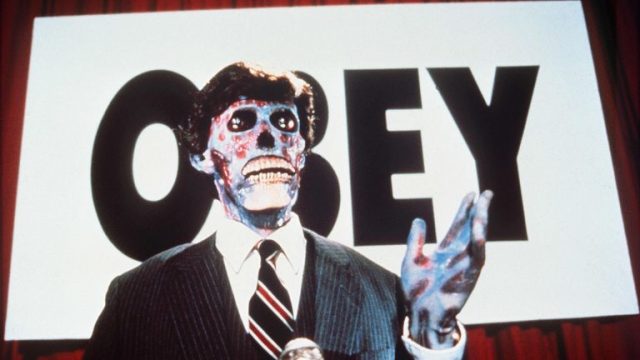Wooooooo! Who’s ready for some horrifying specters of death and ghoulish monsters making noise in the movies to distract us from the horrifying specters of death and ghoulish monsters making noise on the news? [Pulitzer committee: Our contact info can be found below.] This week we have fake blooooood, wiiiiitches, and thiiiiiings.
Send articles throughout the next week to ploughmanplods [at] gmail if you dare (please dare)! Post from the past week below for discussion! Have a Happy Friday!
At The Ringer, Keith Phipps seeks the explanation for the weird look of blood in older horror movies and discovers the laundry-friendly technology responsible:
The distance between Nextel’s blood and the real stuff didn’t go unnoticed. Reviewing Argento’s Deep Red for The New York Times, Vincent Canby called the film “an English-dubbed Italian-made bucket of ax-murder-movie clichés thoroughly soaked in red paint that seems intended to represent fake blood. I don’t think that Dario Argento, the director, meant to distance us from the action in this way. He’s simply a director of incomparable incompetence.” History has largely sided with Argento over Canby, at least when it comes to the overall quality of the director’s classic films. Argento’s blood, however, is another matter. “I was watching clips of Deep Red last night,” Shostrom says, “and it was the same thing. … Even as a kid, I’m thinking, ‘God, didn’t these people ever cut themselves and try to make something that matched?’”
Shannon Miller talks to Rachel True at The AV Club about the changes she brought to her role in The Craft and lying about her age on set:
Also, did you notice that as our powers get stronger, our skirts got shorter? I attribute that to pop culture witchcraft in the ’90s. I think it was used as an analogy for burgeoning female sexuality. You hit that age when you sort of realize the power you can hold over other people just by the fact that you have these new lumps on your chest. You have a lot of feelings going on in your mind and your hips are swinging and all of that. So in a way, yes, it’s about witchcraft. It’s also an analogy for just what women go through and when they feel small and disenfranchised.
Wael Khairy takes to RogerEbert.com to explain why John Carpenter’s The Thing continues to work its horror wonders:
This underlying sense of uncertainty is even present in Ennio Morricone’s score. It plays like an eerie heartbeat to the impending doom lurking inside Outpost 31. The viewer is meant to doubt everyone. This element of doubt is at the core John Campbell’s short story, “Who Goes There?”. According to science fiction historians, Campbell was raised by his mother and aunt; both were identical twins. They enjoyed the game of substituting one another to intentionally confuse him at a very young age. Their antics terrified him; he was never sure if the person standing in front of him was actually his mother or not.
And speaking of the man, Carpenter does an interview with Jake Malooley at Esquire about movies, music, memes and how he’s scared shitless:
I don’t know what to say about the president. It’s horrifying to me. I made They Live back in 1988, and nothing has changed! Everything has stayed the same. Reaganomics has continued to flourish. Occasionally, some good people come along to help run the country, but basically it’s the same. The problem is unrestrained capitalism. It’s worshiped and adored by everybody here. Well, not everybody, but a lot of people. It’s unbelievable, and I’m scared. I’m just scared of the future.
The master of horror is scared?! Things have gone too far! Josh Spiegel, comfort us with insight on Peter Falk and Columbo!
It doesn’t take too long to understand why Peter Falk and Lt. Columbo are culturally attached at the hip. Part of it boils down to the fact that Falk basically was Columbo—the long raincoat and shoes that are synonymous with the detective were the actor’s own. Much of the character’s charm is supplied by Falk as much as by the dialogue itself. Falk established in his memoir, Just One More Thing: Stories From My Life, that he would often deliberately improvise some of the shambling ways in which Columbo disarmed and confused the murderer of the week in order to keep the other actors off-balance. The character, embodying the very concept of the word “rumpled,” shuffles his way into a murder scene—and before the murderer even understands how or why, he’s figured out whodunit.

